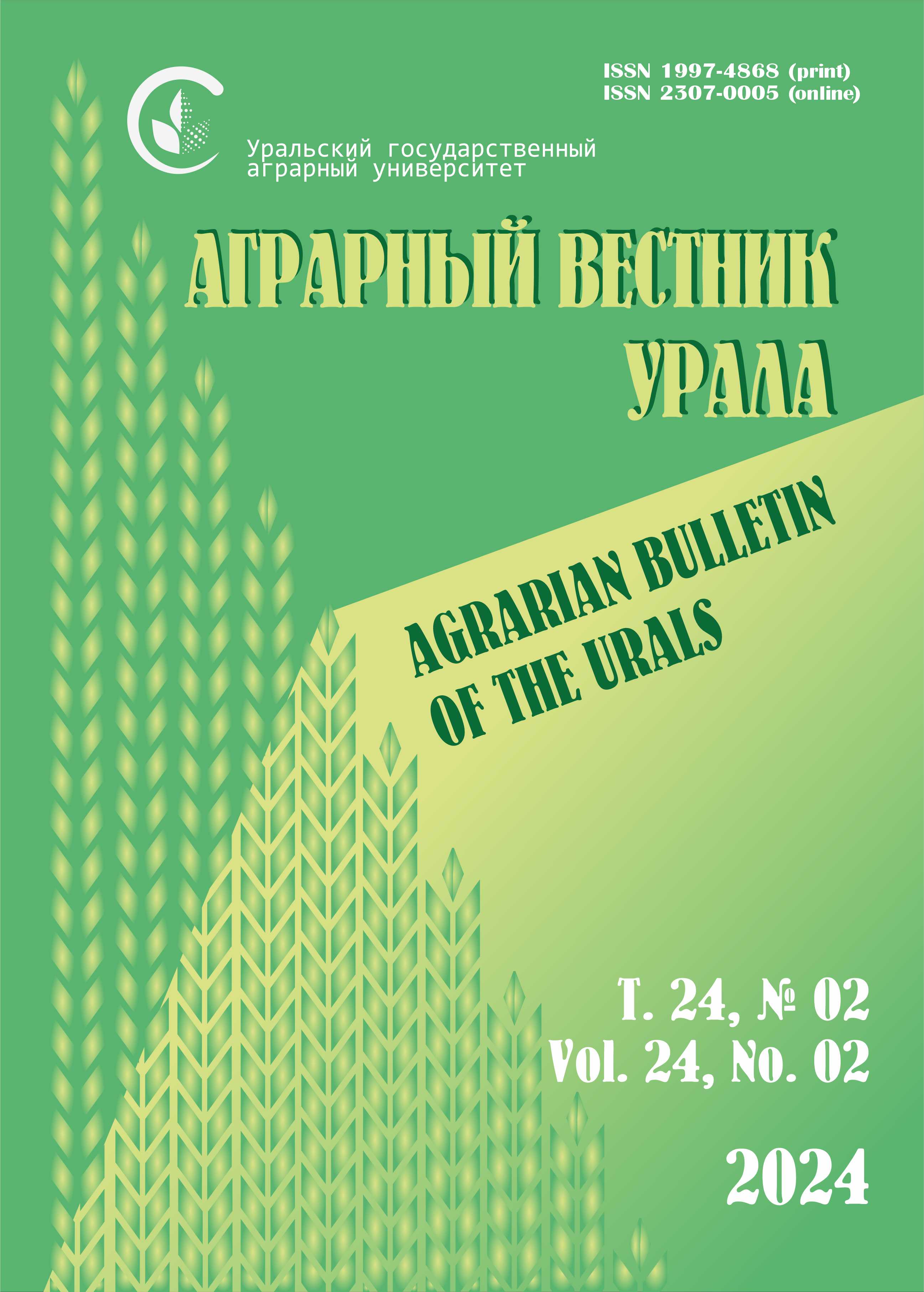Chelyabinsk, Chelyabinsk, Russian Federation
Russian Federation
Abstract. The development of technology for controlled germination of grains and raw ingredients based on them, as well as the adaptation of methods and approaches for each individual crop, is one of the promising areas in the development of a line of food products that meets all the requirements of the modern population. The novelty of the research lies in the use of short-term temperature exposure as a disinfecting step before the process of germination of barley grain and the formation of an evidence base that this type of exposure does not have a negative impact on the remaining technological stages. The purpose of the study was to study the possibility of using barley grain in germination technology for the further production of raw ingredients with increased antioxidant properties. Research methods. The objects of study were barley grain (Hordeum vulgare L.), harvested from 2019 to 2022. The production of sprouted grain included separate technological stages: disinfection (short-term exposure to high temperatures), soaking (in water at 20 ± 2 °C for 20 hours) and germination (in a chamber with a temperature of 22 ± 2 °C and air humidity 95 ± 3 % , with a time range of 12–48 hours). Standard methods were used to evaluate: organoleptic indicators, humidity, nature, mass fraction of protein, ability and energy of germination, as well as microbiological indicators. To select the optimal duration of germination, the total content of flavonoids, polyphenols and antioxidant activity was controlled. Results. As a result of the studies, it was established that the use of short-term thermal exposure at a temperature of 190 °C and a duration of 10 s allows minimizing the risks of activating the development of the present microflora of barley grain. Using the proposed approaches, when carrying out the technological stage of germination, it was possible to identify the optimal duration of the process – 36 hours, which leads to an increase in total antioxidant activity by an average of 46 %, flavonoid content by 560 % and polyphenols by 145 %.
barley grain, disinfection, germination, vegetable raw ingredients
1. Amoah I., Cairncross C., Sturny A., Rush E. Towards improving the nutrition and health of the aged: The role of sprouted grains and encapsulation of bioactive compounds in functional bread - a review. International Journal of Food Science and Technology. 2019; 54: 1435-1447. DOI:https://doi.org/10.1111/ijfs.13934.
2. Lemmens E., Moroni A. V., Pagand J., Heirbaut P., Ritala A., Karlen Y., Lê K., Van den Broeck H. C., Brouns F. J. P. H., De Brier N., Delcour J. A. Impact of cereal seed sprouting on its nutritional and technological properties: A critical review. Comprehensive Reviews in Food Science and Food Safety. 2019; 18: 305-328. DOI:https://doi.org/10.1111/1541-4337.12414.
3. Finnie S., Brovelli V., Nelson D. Sprouted grains as a food ingredient. Sprouted grains / H. Feng, B. Nemzer, J. W. DeVries (Eds.). AACC International Press, 2019. Pp. 113-142. DOI:https://doi.org/10.1016/B978-0-12-811525-1.00006-3.
4. Naumenko N., Fatkullin R., Popova N., Ruskina A., Kalinina I., Morozov R., Avdin V.V., Antonova A., Vasileva E. Effect of a Combination of Ultrasonic Germination and Fermentation Processes on the Antioxidant Activity and γ-Aminobutyric Acid Content of Food Ingredients // Fermentation. 2023; 9: 246. DOI:https://doi.org/10.3390/fermentation9030246.
5. Perri G., Minisci A., Montemurro M., Pontonio E., Verni M., Rizzello C. G. Exploitation of sprouted barley grains and flour through sourdough fermentation. LWT. 2023; 187: 115326. DOI:https://doi.org/10.1016/j.lwt.2023.115326.
6. Franco W., Evert K., Van Nieuwenhove, C. Quinoa Flour, the Germinated Grain Flour, and Sourdough as Alternative Sources for Gluten-Free Bread Formulation: Impact on Chemical, Textural and Sensorial Characteristics. Fermentation. 2021; 7: 115. DOI:https://doi.org/10.3390/fermentation7030115.
7. Sun Y., Mehmood A., Battino M., Xiao J., Chen X. Enrichment of gamma-aminobutyric acid in foods: From conventional methods to innovative technologies. Food Research International. 2022; 162 A: 111801. DOI:https://doi.org/10.1016/j.foodres.2022.111801.
8. RASFF - Food and Feed Safety Alerts [Internet]. [cited 2023 Nov 03]. Available from: http://ec.europa.eu/food/food/rapidalert/rasff_publications_en.htm.
9. Łątka K., Jończyk J., Bajda M. γ-Aminobutyric acid transporters as relevant biological target: Their function, structure, inhibitors and role in the therapy of different diseases. International Journal of Biological Macromolecules. 2020; 158: 750-772.
10. Ding J., Johnson J., Chu Y. F., Feng H. Enhancement of γ-aminobutyric acid, avenanthramides, and other health-promoting metabolites in germinating oats (Avena sativa L.) treated with and without power ultrasound. Food Chemistry. 2019; 283: 239-247.
11. Zhang J., Deng H., Bai J., Zhou X., Zhao Y., Zhu Y., McClementsb D. J., Xiao X., Sun Q. Health-promoting properties of barley: A review of nutrient and nutraceutical composition, functionality, bioprocessing, and health benefits. Critical Reviews in Food Science and Nutrition. 2021. DOI:https://doi.org/10.1080/10408398.2021.1972926.
12. Sharma R., Mokhtari S., Jafari S.M., Sharma S. Barley-based probiotic food mixture: Health effects and future prospects. Critical Reviews in Food Science and Nutrition. 2021. DOI:https://doi.org/10.1080/10408398.2021.1921692.
13. AACC International Approved methods of analysis. 11th ed. [Internet]. St. Paul, MN, USA: AACC International, 2010 [cited 2023 Sep 10]. Available from: https://www.cerealsgrains.org/resources/Methods/Pages/default.aspx.
14. Naumenko N., Potoroko I., Kalinina I. Stimulation of antioxidant activity and γ-aminobutyric acid synthesis in germinated wheat grain Triticum aestivum L. by ultrasound: Increasing the nutritional value of the product. Ultrasonics Sonochemistry. 2022; 86: 106000. DOI:https://doi.org/10.1016/j.ultsonch.2022.106000 11.
15. Babaei-Ghaghelestany A., Alebrahim M. T., MacGregor D. R., Khatami S. A., Hasani Nasab Farzaneh R. Evaluation of ultrasound technology to break seed dormancy of common lambsquarters (Chenopodium album). Food Science & Nutrition. 2020; 8 (6): 2662-2669.
16. Madhu B., Srinivas M. S., Srinivas G., Jain S. Ultrasonic technology and its applications in quality control, processing and preservation of food: A review. Current Journal of Applied Science and Technology. 2019; 32 (5). DOI:https://doi.org/10.9734/CJAST/2019/46909.
17. Tiozon Jr. R. N., Camacho D. H., Bonto A. P., Oyong G. G., Sreenivasulu N. Efficient fortification of folic acid in rice through ultrasonic treatment and absorption. Food Chemistry. 2021; 335: 127629.










